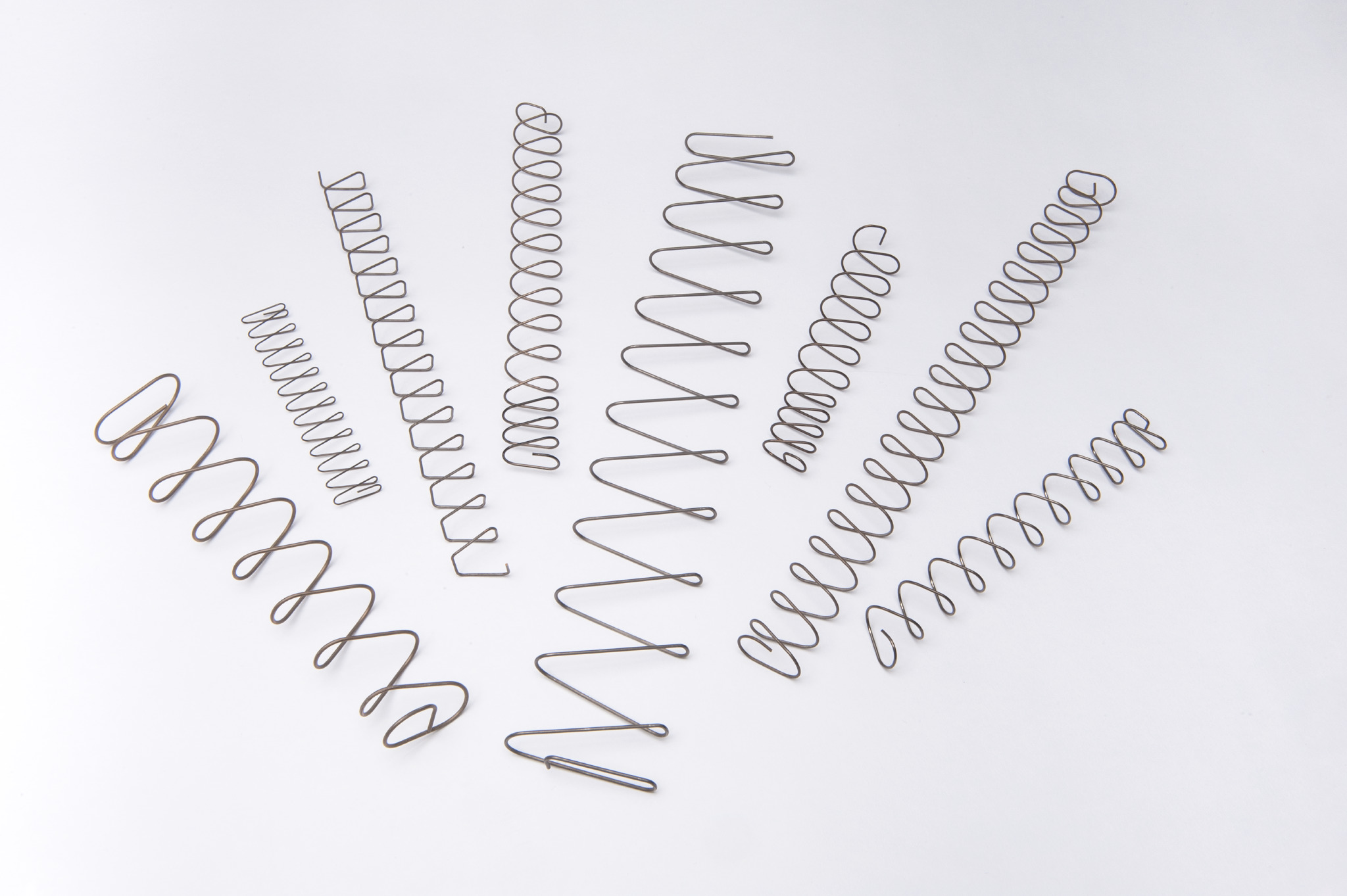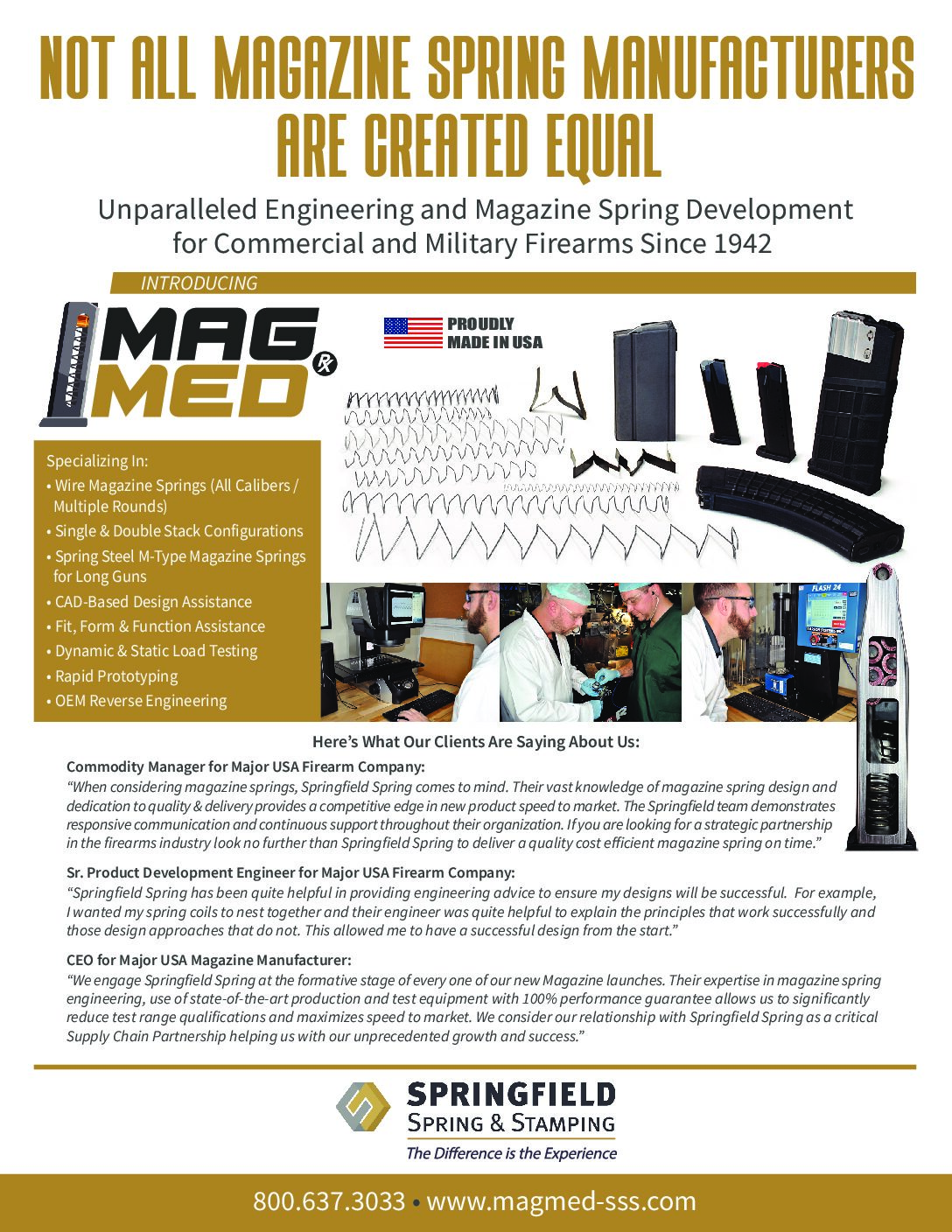Magazine Springs
Magazine springs are a crucial component in firearms, specifically in the magazines where they are used to feed ammunition into the chamber reliably. These springs ensure the consistent and smooth operation of the firearm by exerting pressure that pushes the rounds up into the feed mechanism. Springfield Spring & Stamping’s magazine springs are manufactured to your exact specifications and available in quantities from single units into the millions.
The importance of magazine springs lies in their role in ensuring the reliable functioning of a firearm, which is critical for both safety and performance. Inadequate or faulty springs can lead to misfires, jams, and other operational issues, compromising the effectiveness of the firearm. Therefore, the quality, design, and manufacturing of magazine springs are of paramount importance in firearms engineering.
Their application, while most notable in firearms, extends to various other industries where precision and reliability are essential. This includes medical devices, defense equipment, and other machinery where springs play a critical role in the mechanism’s operation.

Fundamentals of Magazine Springs
Magazine springs are specialized springs designed for use in firearm magazines, where they function to feed ammunition reliably into the chamber. These springs come in various types, each tailored to different magazine designs and firearm specifications. Common types include compression springs, which are the most prevalent in traditional magazines, and torsion springs, used in some modern designs. The configuration of these springs, such as single or double stack, varies based on the magazine’s capacity and design.
The design of magazine springs focuses on achieving consistent force and enduring cyclic loading without failure. Key considerations include the spring’s length, wire diameter, coil diameter, and the number of coils. These factors are meticulously calculated to ensure that the spring provides the necessary force to feed rounds smoothly while avoiding over-compression or rapid wear. The design must account for the space constraints of the magazine and the specific demands of the firearm’s feeding mechanism.
The choice of material for magazine springs is critical for their performance and longevity. Common materials include:
- Music Wire: Known for its high tensile strength and fatigue resistance, making it ideal for high-stress applications.
- Stainless Steel: Offers excellent corrosion resistance and is used in environments where rust or corrosion is a concern.
- High-Temperature Alloys: These are used in applications where the spring must perform under extreme temperatures without losing its mechanical properties. Each material offers unique properties like strength, flexibility, and resistance to environmental factors, making the selection process crucial to the spring’s overall performance and durability.
Manufacturing Techniques in Magazine Springs
CNC-Controlled Machinery: Computer Numerical Control (CNC) machines are widely used in spring manufacturing for their precision and consistency. They can rapidly produce springs with exact specifications, handling complex shapes and designs.
Wire Forming: This involves bending and shaping metal wire into springs. Advanced wire forming machines can handle various wire sizes and materials, allowing for a range of spring types.
Quality Control and Testing Procedures
Material Inspection: Ensures the raw materials meet specific standards.
Dimensional Inspection: Checks the springs against design specifications.
Load Testing: Ensures the springs can withstand the required forces without deformation.
Fatigue Testing: Tests the durability of springs under repeated stress.
Customization Capabilities and Scalability
Customization: Modern machinery allows for high customization, enabling the production of springs tailored to specific requirements.
Scalability: Advanced manufacturing techniques enable scalable production, from small batches to large-scale runs, without compromising quality or precision.
Challenges and Solutions in Magazine Spring Manufacturing
Challenges in Magazine Springs: A key challenge in magazine spring manufacturing is managing material fatigue, which can lead to spring failure over time. Consistency in spring performance is another significant concern, as any variation can affect the reliability of the magazine, especially in critical applications like firearms. Environmental factors such as corrosion, temperature changes, and mechanical wear also pose challenges, impacting the longevity and efficiency of the springs.
Solutions & Best Practices: To address these challenges, industry best practices include the selection of high-quality, fatigue-resistant materials, such as specific steel alloys or high-temperature materials. Advanced manufacturing techniques like precision CNC machining and computer-aided design (CAD) play a crucial role in ensuring consistent quality and precise dimensions. Regular quality testing, including load and fatigue testing, ensures that the springs meet stringent performance criteria. Optimizing the design, like adjusting the number of coils and wire diameter, can enhance the spring’s life and functionality.
The Springfield Spring Advantage: Springfield Spring & Stamping, with our emphasis on precision and quality, embodies these industry best practices. From the state-of-the-art machinery, to the range of material options, to the rigorous quality control measures, our springs exceed industry standards for overcoming common challenges in magazine spring design and manufacturing. Our customization capabilities and innovative approaches, such as the MAGMED program for rapid prototyping and design assistance, demonstrate a commitment to producing high-quality, reliable magazine springs suited to a variety of demanding applications. Contact our team today to discuss your magazine spring needs!
Capabilities
At Springfield Spring & Stamping, wire diameters can range from .008″ to .135″ (.201 to 3.4 mm). Magazine springs can be crafted in many materials, from high-temperature alloys to music wire, with an equally expansive variety of coatings to choose from.
Why Choose Us?
Springfield Spring & Stamping is committed to helping you get the custom magazine springs you need. Through our MagMed program, our engineers can identify alternative materials, tolerances, and manufacturing methods to make your custom spring production more economical.
Get Started
International shipping is available! For additional information about our custom springs or other products we offer, contact us today!
Engineered Ammunition Delivery Systems
Some call it a Magazine Spring, we refer to them as Engineered Ammunition Delivery Systems.
Using state-of-the-art CNC-controlled machinery and Solidworks CAD software, Springfield Spring & Stampings Engineering and Production Teams have developed an innovative magazine spring qualification program capable of helping customers significantly reduce the amount of time necessary to bring new magazine springs to the market. Our MAGMED program offers:
- Rapid Prototyping – 1 to 2 weeks to optimize form, fit & function
- Magazine Spring design assistance (All Calibers / Multiple Rounds)
- Material selection (High Tensile Missile Music Wire, 17-7 Stainless Steel)
- Single & Double Stack Configurations
- CAD-based drawing assistance
- OEM Reverse Engineering
- Dynamic & Static Load Testing
- Surface coatings (Passivation – Dry Film Lubrication – Black Oxide)
- Special packaging to minimize entanglement

Magazine Spring FAQs
What material types are available for magazine springs?
Magazine springs can be made from any of the following materials:
- Music Wire
- High Tensile Music Wire
- Pre Tin-Coated Music Wire
- Hard Drawn MB
- Oil Tempered
- Stainless Steel
- Phosphor Bronze
- Beryllium Copper
- Brass
- Inconel
- High Temperature Alloys
- Chrome Vanadium
What are wire diameter capabilities for compression springs?
Our wire diameter capabilities range from 0.008″ to 0.135″
|
Wire Diameter Min. .008 in |
Wire Diameter Max. .135 in |
What file types are acceptable for submitting a drawing?
We utilize CADKEY Creator and can translate most of the common CAD files for use. Here is a complete list of file formats we can work with:
- AutoCAD (DWG and DXF)
- BMP
- Bit Mapped Graphics
- GIF
- Graphics Interchange Format
- IGES
- JPG or JEPG
- Joint Photographic Experts Group
- PDF
- TIFF
- Tagged Image File Format
Do you have the capabilities for secondary finishes on magazine springs?
Yes, all of our components can have additional processing based on the end application requirements. Some examples of secondary finishes for magazine springs are as follows:
- Black Oxide
- Color Code
- Gold Plating
- Manganese Phosphate
- Nickel Plating
- Painting
- Passivation
- Phosphate w/ Oil
- Powder Coated
- Tin
- Varnish
- Zinc (Clear and Yellow)
Interested in a secondary process not listed above? Reach out to our team and we can discuss together.
What spring and stamping manufacturing equipment do you have?
A complete list of our equipment is as follows:
- Itaya MX-10, MX-20, RX-20 CNC Spring Forming Machines
- Primera Precision ZX-250 CNC Spring and Wire Formers
- Vinston CCM-12-236 R, CMM-12-450 R Camless Multi-Axis Rotary Wire Spring Formers
- Nilson Four Slide 4 Ton, 5 Ton, 7 Ton, and 20 Ton
- Bihler MK3 – B20-01-0001 Servo-controlled Stamping and Forming Machine
- Fenn-Torin FZ Series CNC Spring Coilers
- Moyer CNC Spring Grinders
- MicroStudio MC54-30 Automated Setting and Sorting Machine
- Tool and Die fabrication. CNC Machining, Wire EDM
Do you provide secondary services such as PPAPs for magazine springs?
Yes! Our team has experience conducting PPAPs. We also offer Pre-Qualifying Engineering Cost Reduction Programs, Statistical Process Control (SPC), and Automotive FMEA.
What volumes are available?
Our volumes range from a single piece prototype to production volumes in the millions to everything in between.
Learn more about what critical to function means to us
It’s not just a stamping, it’s not just a wireform, it’s not just a spring. It HAS to work. You can’t risk your medical or defense product to not work every time. At Springfield Spring, we partner with your team to solve your most complex problems. Our products are tested and engineered to work every time as they’re supposed to function. We strive to make the best springs, stampings, wireforms and fourslide parts.
